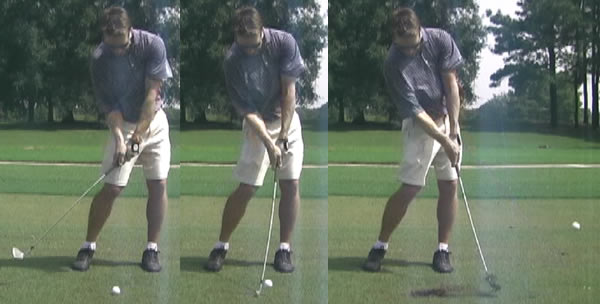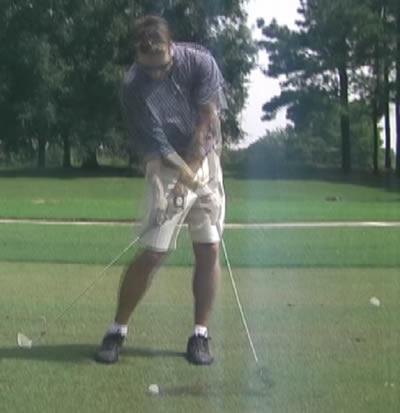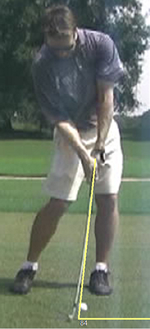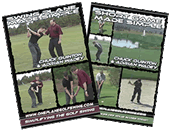Full Swing
Rotary Swing Tour - Anatomical Absolutes of Golf
Rotary Golf Learning Series
Golf Biomechanics Home Page
1. RST Overview
2. Use of the Hips and Core - Driver Swing
3. Biomechanically Correct Golf Setup and Balance
4. Functional Squat and One Legged Exercises
5. Functional Bridge Exercises
6. Inner Thigh/Hip Exercise
7. Back Stabilizer Exercise
8. Push vs. Pull
9. Golf Core Rotation Exercises
10. Golf Swing Weight Shift - Part 1
11. Golf Swing Weight Shift - To the Right - Part 2
12. Golf Swing Weight Shift - To the Left - Part 3
13. Sean O'Hair - Rotary Swing Tour
14. Common Swing Faults Caused by Setup
15. The Takeaway in the Golf Swing
16. Understanding Shoulder Elevation
17. The Role of the Right Arm in the Takeaway
18. Posture's Affect on the Takeaway
19. Golf Instruction - Muscle Activation
20. Tiger Woods Biomechanics
21. Move 2 - Completing the Backswing
22. Move 3 - The Golf Downswing
23. Creating a Golf Swing Plane
24. Effects of Bad Ball Position
25. 9 to 3 Drill
26. Move 4 - The Follow Through
27. Common Faults in the Follow Through
28. Tiger Woods - Getting Stuck - Downswing
29. Throw the Ball Drill
30. Right Arm Only - Downswing Drill
Rotary Swing Fundamentals
1. Golf Swing Fundamentals Home
2. Athletic Address Position
3. Body Movement
4. The Arms in the Golf Swing
5. Golf Spine Angle
6. Golfswing Takeaway
7. Proper Golf Grip
8. Golf Swing Rhythm Drill
9. Starting the Swing
10. Proper Divot
11.Forearm/Shaft Alignment
12. Head Behind the Ball
13. Golf Swing Wrist Hinge & Cock
14. Hip Turn
15. Hip Rotation Through Impact
16. Takeaway Chin Line
17. Passive Arms in the Golf Swing
18. Biomechanically Shorten Backswing
19. Rotation vs. Tilting Shoulders
20. Golf Swing Transition Bump
Rotary Golf Swing Drills
1. Golf Swing Drills Home
2. Body Drill
3. Impact Bag
4. Divots Left Tee Drill
5. Golf Baseball Swings
6. Broom Drill
7. One Leg Drill
8. Headcover Drill
9. Foam Roller Drill
10. Ben Hogan Pane of Glass
11. Shaft Plane Drill
12. Slide the Shaft Drill
13. 9 o'clock Swing Plane
14. Rotary Drill
15. Penetrating Flight Drill
16. In to Out Tee Drill
17. Neck Tie Drill
18. Bucket Drill for Synchronization
19. Lag Drill - Improve Your Golf Swing
Faults and Fixes
1. Faults & Fixes Home
2. Understanding Your Misses
3. Fixing a Hook
4. Fixing a Slice
5. Hitting Fat
6. Hitting Thin
7. Shots off the Toe
8. Shots off the Heel - Shanking
9. Left Side Breakdown
10. Pulled Shots - Student Analysis
11. Slicing
12. Coming Too Far From the Inside
Advanced Technique
1. Advanced Technique Home
2. Impact vs Address
3. Fade vs Draw
4. Hitting a Draw
5. Hitting a Fade
6. Hit It Low
7. Hit It High
8. Tiger Woods 2 Iron Stinger
9. Driver off the Deck
10. The Three Releases
11. Pinky Grip
12. Arms vs Body Release
Rotary Hitter
1. Rotary Hitter Intro
2. Impact Position
3. Chip Stroke
4. Hitter Backswing
5. Shoulder Turn and Right Arm Throwing Motion
6. Hitter Takeaway
7. Hitter vs Swinger
8. Right Hand Pressure Point w/ the Pure Ball Striker
Two Plane
Golf Impact Video Series
Short Game
1. Swinging Over the Top
2. Flat Left Wrist
3. Driver vs. Irons at Impact
4. Impact Fix Drill
5. Importance of Proper Grip
Bomb Your Driver Series
1. Bomb Your Driver Home Page
2. Ball Speed
3. Clubface Roll
4. Driver Sweetspot
5. Optimum Ball Launch Angle
6. Driver Golf Ball Spin Rate
7. Increase Clubhead Speed with More Lag!
8. Tiger Woods Most Inefficient Driver on PGA Tour
9. Driver Head Center of Gravity Design
Performance Putting Series
Putting
Mental Game
1. Forearm Shaft Alignment
2. Putting Distance Control
3. Putting Shaft Drill
4. Putting Acceleration Drill
5. Putting Hand Dominance
6. Face Angle in the Putting Stroke
7. Pendulum Putting Stroke
8. Putting Fitting - Shaft Length and Setup
Wedge Play
Mushin Golf
Golf Instruction
1. Mental Game Home
2. Introduction
3. Taking it to the Course
4. 10 Mental Principals
5. Confidence
6. You Are An Athlete
7. Spring Golf
8. Ultimate Destroyer
9. How To Practice
10. Developing a Mental Putting Routine
Course Management
1. Rotary Swing Golf Academy
2. In Person w/ Chuck Quinton
3. Driver Fittings
4. Demo Matrix Shafts and Nakashima Heads
5. Online Golf Lessons
6. Flightscope Kudu Launch Monitor at RSGA
Golf Equipment
1. Properly Fit Shafts
2. 2006 Golf Ball Review
3. Using a Launch Monitor
4. Sandwedge Bounce Angle
5. Flightscope Kudu Launch Monitor at RSGA
6. Demo a Matrix Driver Shaft!
7. Eyeline Golf Putting Plane
Professional Swings
Pro Golf Swing Sequences Home
Ben Hogan
Member's Swings
Golf Fitness
1. Ben Hogan's Swing
2. Ben Hogan's Shoulder Plane
3. Ben Hogan's Swing Face On
4. Ben Hogan's Swing Down the Line5. Ben Hogan - Reverse Pivot?
6. Ben Hogan's Address Position
Tiger Woods
1. Tiger Woods Swing Dynamics
2. Tiger Woods New Swing with Hank Haney
3. Tiger Woods Address
4. Tiger Woods Takeaway
5. Tiger Woods Backswing
6. Tiger Woods Downswing & Impact
7. Tiger Woods Most Inefficient Driver on PGA Tour
Chuck Quinton
1. Quinton 6 Iron Down the Line
2. 6 Iron Face On
3. Driver Face On
4. Driver Down the Line
5. Chuck Quinton DTL Analysis
6. Quinton Face On Swing Analysis
7. TaylorMade Performance Lab
Paul Dickinson
Stuart Appleby
Ernie Els Golf Swing DTL
Ernie Els Grip
Jose Maria Olazabal
Annika Sorenstam
Peter Jacobsen
Sam Snead
Adrian Wadey Face On
Adrian Wadey Down the Line
Tyler Aldridge 2007 PGA Tour Qualifying School
1. Golf Fitness Exercises
2. Hitting with Your Core
3. Balance on Swiss Ball
4. Golf Fitness Bridge Exercise
5. Stretching the Core
6. Advanced Leg Exercises
7. Intermediate Let Exercises
8. Losing Spine Angle in Golf Swing
Membership Info
Golf Tips & Info
1. One Plane vs. Two Plane Swing
2. One Plane Swing in Depth
3. Model Golf vs. One Plane
4. My Swing Philosophy
5. List of One Plane/Rotary Swing Instructors
6. Golf Chat Live Transcript
7. Golf Blog
8. Analyzing Golf Ball Flight
9. Stop Casting the Club
10. Causes of a Slice
11. Core Performance Golf
12. Efficiency of Movement
13. Fred Couples Golf Swing
14. Releasing the Golf Club
15. Hank Haney's Swing with Tiger Woods
16. Iron Shaft Survey
17. Key Components to Hardy's Swing
18. Losing Spine Angle
19. Mixing One and Two Plane Swing Fundamentals
20. Mushin Golf
21. Passive vs. Active Arms
22. Problem with Jim Hardy's Swing
23. Secret of Clubhead Lag
24. Right Arm in Golf Swing
25. Stuart Appleby's Golf Swing Video
26. Clubface Angle Video
27. Tiger Woods New Swing
by Chuck Quinton
Taking a Proper Divot in the Golf Swing |
Rotary Swing Golf |
![]() Watch Taking a Proper Divot Video
Watch Taking a Proper Divot Video
Taking a proper divot is something that is critical to crisp and consistent iron play, but if you don't know what a proper divot is, it's tough to know when things go wrong. Below, we're going to take a look at the proper divot from the face on view. Study the photographs below:

In the above sequnce, you can see how the divot doesn't start until long after the ball is already gone. In the middle picture just after impact, the ball is well in the air and no dirt has flown up as of yet. In the last picture on the right, you can see how the divot started in front of the ball about an inch and extended to be even with my left big toe, or about the length of a dollar bill. It is key to learn to take more shallow divots for spin and trajectory control. If you are taking massive divots, it becomes very difficult to control the distance of your irons and you will tend to put too much spin on the ball. A shallow divot is one where the top layer of turf is removed but you can still see the grass roots below. If your divots are deep and you're seeing a lot of dark soil at the bottom of the divot, it's likely too deep for consitent iron play. To further illustrate this, look at the photo below:

Here you can see an overlay showing the ball just before impact and the divot extending past the ball after impact. It is critical for your divots to start after the front of the ball for crisp iron shots and consistency. A good way to practice this is to actually hit ball off a tee. Take a 7 iron and place the ball on a tee but tee it very low such that the tee is barely above the level of the dirt about 1/8". Now hit full shots off the tee and try and make sure that the tee remains undisturbed. Your divot should start about an inch in front of the tee and the tee should not be clipped or broken. While this drill may seem simple at first, many golfers struggle with it, so don't take it too lightly. Spend time with it until you get very competent with not striking the tee with the club and you will see your ball flight become more penetrating just like the pros. As you become better with the drill, you should find that you can practice within a very small area without tearing up a lot of sod. Nicklaus used to say that he could practice all day in an area about the size of shoe box. That's a great visual if you're used to tearing up large chunks of turf on the practice tee.
The key to getting these divots to start in front of the ball is to make sure your hands lead the club through impact. Notice in the photo below, my hands are just in front of the ball at impact with a short iron. They only need to lead slightly, about 5 degrees is plenty for most iron shots. In the photo below, the shaft is leading about 6 degrees from the butt of the club and then several more because of the bend in the shaft. You are seeking the ideal balance between launch angle, trajectory and spin for control with your irons, and striking down on the ball is the key to great iron play. Practice not clipping the tee in the above drill and watch your iron play improve.

|
|
|
| ||||||||



